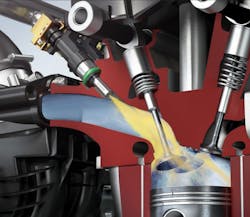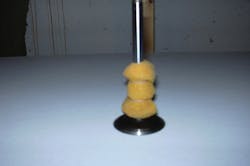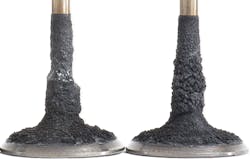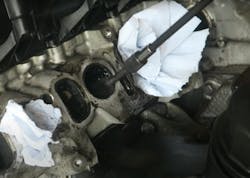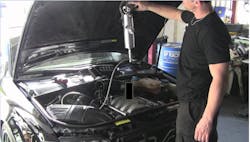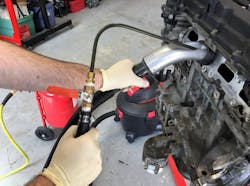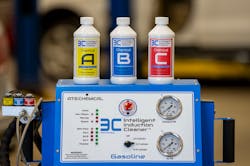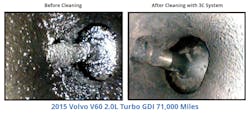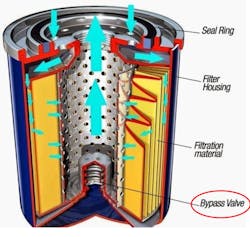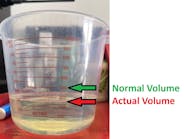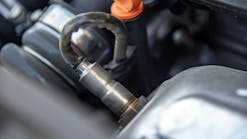Content brought to you by Motor Age. To subscribe, click here.
What You Will Learn:
- The differences between port fuel injection and GDI
- How carbon causes misfires
- Countermeasures to reduce carbon
- Importance of proper maintenance and product use
Since the existence of the internal combustion engine, automotive technicians have been forced to deal with the effects of carbon buildup. As a byproduct of combustion, carbon develops as the hydrocarbons of fuels such as gasoline and diesel are chemically converted to energy. What is left over is the soot we used to see bellowing out of the smokestacks as large rigs accelerated down the road. That same soot collects within the exhaust system, but more noticeably in the induction systems of the engines they are supplying. Traditionally, when carbon buildup became excessive, driveability faults (such as tip-in hesitation and smoking tailpipes under closed-throttle deceleration) became evident. That is when we were paid a visit from our customers. With today's prevalent GDI (gasoline direct Injection) vehicles, the story is the same, but the effects of carbon are a lot more pronounced. Let's talk about how and why -- and some solutions to the problem.
Port fuel injection vs. GDI
As we are all well aware, the port-injected engine's fuel injectors delivered fuel to the individual intake runners of each cylinder. The fuel delivered in this fashion provided the desirable byproduct of the gasoline serving as a cleaning agent. Each time the fuel injector delivered its dose, the fuel would wash the carbon from the back of the intake valves/seats, preventing any buildup from occurring. Because of this, engines of port injection design didn't tend to suffer from the effects of carbon buildup as described above (Figure 1), although there were exceptions.
With the advancement in technology and the ever-tightening noose of emissions standards came the GDI engine platforms. These engines boast big power output, high fuel mileage, and minimized tailpipe emissions...the perfect trio! Couple that with variable cam timing, variable valve lift/duration, and turbocharging, and you've got one heck of an efficient powerplant.
With specially designed pistons, the incoming air charge and the fuel dose from the injector meet the piston near the top dead center of the compression stroke. The way the air enters the combustion chamber and how the fuel is atomized is crucial to the combustion process of the GDI engine. This is known as a stratified charge and promotes complete combustion with great efficiency.
But the downside to the GDI engine is its sensitivity to carbon buildup. The GDI engine’s fuel injector arrangement is exactly how it sounds. It doses each cylinder with fuel “directly.” What this means is that the fuel is no longer sprayed on the back of the intake valve and no longer serves as that cleaning agent to prevent the carbon buildup from occurring (Figure 2). This is just a natural occurrence due to the design of the GDI system. It’s not biased to one auto manufacturer over the other.
Carbon-caused misfires
Early on, many theorized that the source of the idle-speed misfires related to carbon was similar to misfires caused by the carbon effects of yesterday. They believed that the carbon was serving as a sponge and absorbing the fuel that was intended for the combustion chamber (Figure 3). In actuality, the misfires are due to the disruption of airflow into the combustion chambers. This symptom is particularly present during cold-start idle conditions.
As mentioned before, the airflow or how the air tumbles into the cylinder is crucial to the combustion process. When the carbon sets up in the intake ports and/or around the stem of the intake valves (Figure 4), it creates turbulence. This alters the way the air tumbles into the cylinder.
The GDI combustion event relies on a curtain of air to encompass the fuel charge like a cloak, preventing the fuel from condensing on the cylinder walls. The overall air/fuel ratio in the cylinder can be extremely lean (upwards of 65:1, in Honda’s 2.0L i-VTEC engine). However, the center of the charge, where the spark will be concentrated, is abundant in fuel. The air and fuel molecules are held very close together due to this design and allow the flame front to propagate easily across the air/fuel charge (Figure 5).
To visualize this, think of setting fire to a few scraps of paper. One would be sure to have the pieces of paper close enough to one another so the flame could easily propagate from piece to piece. If the paper pieces were too far spread apart, the fire would soon extinguish, and leftover paper pieces would remain.
Regarding the GDI engine, when the air is disrupted due to the turbulence created by the carbon, the air will not homogenize properly with the fuel molecules. There will be pockets of lean AF mixture. As a result, improper or insufficient combustion will occur and can be felt by the driver as a misfire.
All the flavors of carbon
Some manufacturers don’t offer any preventive countermeasures to battle carbon buildup. When severe driveability symptoms surface because of carbon buildup, removal of the cylinder head for carbon cleaning is the procedure called upon in the service information (Figure 6).
There certainly are countermeasures that exist to reduce or remove carbon from these GDI engines. Some are effective, and some...well, not so much, but there’s no need to name any names here. Understand that the intentions were good and these chemical treatments/additives I speak of are not a gimmick. They do work!
I’m one that truly believes in preventive maintenance. It’s quite common for one to experience carbon buildup (and even the effects thereof) as early as 15,000 miles on the odometer. I’ve seen it with my own eye! With that said, the employment of a chemical induction system service and/or fuel system additive is not a bad idea, from a preventive maintenance aspect (Figure 7). Certainly, adhere to the manufacturers' recommendations or only deviate from them at your own risk.
However, in my experience as a technician, most customers don't maintain their vehicles that well and fail to address the induction system that early on. As a result, the only time I see them address carbon is when a driveability fault surfaces and needs to be rectified to alleviate a MIL or to pass a state-mandated emissions test. Typically, when carbon becomes that bad to create a driveability fault, the chemical induction fogging treatments demonstrated above aren't always your best option. They don't seem to be very effective once the symptoms surface.
As a result, as technicians we are left with two other effective options. The first is a typical solution that involves media blasting. The intake manifold is removed to expose the intake ports. In many cases, media such as pulverized walnut shells are propelled against the carbon-covered surfaces using compressed shop air. The media is simultaneously recovered using a shop vacuum (Figure 8). Although messy, the process gives excellent results, and the valves/ports look brand new once the service is complete. This is probably the most effective method. However, in many cases, access to the intake ports could take many hours and can be a tough sell to a customer, knowing it will likely occur again if countermeasures aren't taken after the service.
Another option involves a chemical treatment and pulsed/pressurized air introduced to the induction system. However, it is done so using three different types of chemicals (to address all the different types of carbon that are layered upon one another).
Don’t get me wrong; I’m not here to promote any specific brand name. It’s the functionality of the tool that makes it worth mentioning. The tool is called the 3C Intelligent Induction Cleaner by Automotive Test Solutions (Figure 9). Six years of chemical development created compositions the automotive industry has never seen before. It systematically strips the carbon from the induction system, layer by layer due to the staggering of the three chemicals and unique delivery methods.
I mention this tool because it is an extremely effective preventive maintenance countermeasure and equally as effective for eliminating driveability faults. It consumes the carbon and eliminates it (effectively eliminating the turbulence), rather than redistributing it on the turbo impeller or catalytic converter. It provides a tremendous alternative to engine teardown and can be performed in a timely and affordable fashion. Again, this provides another option to the customer (Figure 10).
NOTE: Some engines cannot be cleaned chemically due to the design of the induction system.
Proper maintenance and products are key
So where does this carbon come from? Believe me when I tell you that most of the carbon issues, we see can be directly related to the design of the GDI engine. However, there is more to it than that. Many customers are still attracted to the “$19.95 Oil Change Special.” Ask yourself this question…How can an oil/filter change with labor and tax charges be so inexpensive?" The quality of the products used is what comes into play. Not all oils are created equal. Just because the bottle is labeled as a "5W-20" (indication of viscosity) doesn't mean it has the additives necessary to meet the specifications designed for the vehicle being serviced. The oil’s additive packages are what allow characteristics like "15k mile intervals” to exist. Running an economically priced oil for that interval will not always support the engine's requirements. Also, consider the filter. Some filters work perfectly, but for 3k miles. The filtering media won't carry any more contaminants after that. The problem is, there is no warning or indication. Once the filtering media is loaded, the bypass valve in the filter simply opens due to pressure buildup and allows unfiltered oil to circulate through the engine (Figure 11).
As oil breaks down chemically, sludge begins to form. Piston rings begin to stick in the ring lands and blow-by begins to occur, contaminating the crankcase and eventually the PCV system with combustion gases. The PCV system recirculates its contents back to the induction system and the particulates begin to collect. It’s this lack of proper maintenance that is the real problem. Not only does it lead to the turbulent-induced idle misfires described earlier, but eventually it can be so restrictive the cylinders struggle to "breathe” under heavy load/higher RPMs. Vehicles will exhibit a lack of power and poor combustion, and this condition can lead to catalyst failure as well. This picture is a pre- and post-induction system cleaning, using a lab scope and pressure transducer at the intake manifold to demonstrate how each cylinder inhales, relative to the others. It's easy to see that carbon hinders volumetric efficiency (Figure 12).
So, how can we prevent this mayhem from occurring? It begins with education. Educate yourselves and your fellow team members on the importance of preventive maintenance and quality products (like oils and filters). Once that is understood, we can properly educate the customer on the importance of avoiding these "budget" services and get them on track to maintaining their vehicles properly. I think you'll find in time that the customers are more than happy to spend the extra money, once they truly understand what that investment will do for the longevity of their vehicles.
